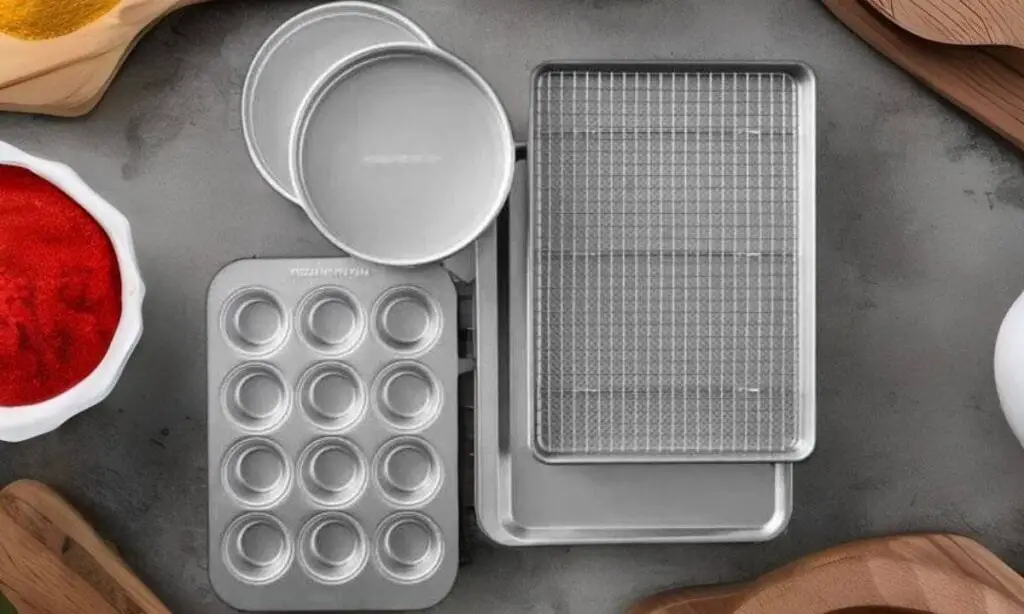If you’re passionate about baking, you know how important it is to use the right tools and techniques to create the perfect baked goods. One material that has gained popularity in recent years is aluminized steel bakeware. But what exactly is aluminized steel, and why is it a good choice for baking?
In this post, I’ll explore the composition, thermal conductivity, strength, cost, safety, and performance of aluminized steel bakeware. I’ll also compare aluminized steel to stainless steel and aluminum, two other commonly used metals in baking.
What is Aluminized Steel Bakeware?

Aluminized steel is a type of steel that has been coated with aluminum to enhance its properties. The coating provides a protective layer against corrosion, while also improving the metal’s heat transfer characteristics.
Let’s take a closer look at the benefits of using aluminized steel bakeware.
Benefits of Using Aluminized Steel Bakeware
Aluminized steel bakeware offers several advantages over other materials. Here are some of the key benefits:
- Enhanced heat transfer: Aluminized steel conducts heat more efficiently than traditional steel or aluminum, resulting in more even baking and better browning.
- Temperature control: Aluminized steel heats up quickly and cools down rapidly, allowing for precise temperature control when baking.
- Durability: Aluminized steel is highly resistant to corrosion and wear, making it a durable choice for baking pans and sheets.
- Cost-effective: Aluminized steel is less expensive than other metals commonly used in baking, such as copper or cast iron.
Now that I’ve looked at the benefits of aluminized steel, let’s dive deeper into its composition.
Composition of Aluminized Steel
Aluminized steel is made by dipping raw steel into a bath of molten aluminum mixed with silicone. This process creates a three-layered structure with an iron core, two layers of aluminum, and an oxidized outer layer.
The result is a material that combines the strength and durability of steel with the enhanced heat transfer properties of aluminum.
Here are some of the key components and properties of aluminized steel:
Components of Aluminized Steel
- Iron: Provides the core strength and structural integrity of the material.
- Aluminum: Enhances the heat transfer properties of the steel.
- Silicone: Prevents the aluminum from reacting with the iron and causing oxidation.
Properties of Aluminized Steel
- High thermal conductivity: Aluminized steel conducts heat more efficiently than traditional steel or aluminum.
- Resistance to corrosion: The aluminum coating protects the steel from rust and corrosion.
- Durability: Aluminized steel is strong and long-lasting, resistant to wear and tear.
- Non-reactive: Unlike some other metals, aluminized steel does not react with acidic foods.
Now that I understand the components and properties of aluminized steel, let’s see how it compares to other materials in terms of thermal conductivity and strength.
Thermal Conductivity of Aluminized Steel
Thermal conductivity refers to a material’s ability to conduct heat. In baking, it’s important to use a material that can transfer heat evenly and quickly to ensure that your baked goods cook evenly and have a nice golden brown finish.
Aluminized steel has excellent thermal conductivity, thanks to its combination of steel and aluminum. It heats up quickly and distributes heat evenly across the surface of the pan or sheet.
This makes aluminized steel ideal for baking a wide variety of foods, from delicate pastries to hearty breads and roasts.
Strength of Aluminized Steel
Another important consideration when choosing bakeware is its strength and durability. You want a material that can withstand high temperatures and resist corrosion, ensuring that your pans and sheets last for years.
Aluminized steel excels in both of these areas. Its aluminum coating protects the steel from rust and corrosion, while its inherent strength and durability make it resistant to wear and tear.
In fact, aluminized steel is often used in industrial settings, such as furnaces and ovens, where it must withstand extreme temperatures and harsh conditions.
Cost of Aluminized Steel
One of the most appealing aspects of aluminized steel bakeware is its affordability. Compared to other metals commonly used in baking, such as copper or cast iron, aluminized steel is much less expensive.
This makes it an excellent choice for home bakers who want high-quality bakeware without breaking the bank.
Is Aluminized Steel Bakeware Safe?
While aluminized steel is generally considered safe for baking, there are some concerns about the potential health risks of using aluminum cookware.
Research has shown that high levels of aluminum in the body may be linked to certain health problems, such as Alzheimer’s disease. However, the amount of aluminum that leaches into food from aluminized steel bakeware is generally considered.
FAQs
Is it safe to bake with aluminized steel?
Aluminized steel bakeware is safe to use as long as it is cared for properly. However, care should be taken when using and cleaning them. According to some sources, aluminized steel bakeware may be unsafe if it is damaged, chipped, or scratched. It is generally non-leaching but may leach at high heats in the presence of fat and especially for longer periods of time.
Which is better aluminized steel or stainless steel?
Both aluminized steel and stainless steel have their own advantages and disadvantages. Stainless steel is stronger, more durable, and does not rust. On the other hand, aluminized steel has high thermal conductivity and an electrostatic surface. Stainless steel is more expensive than aluminized steel, but it is not necessarily stronger as it can be more brittle than aluminized steel. The choice between the two depends on the specific application and requirements.
What material is best for bakeware?
There are several materials that are commonly used for bakeware, each with its own advantages and disadvantages. Some popular options include anodized aluminum, aluminized steel, stainless steel, silicone, glass, cast iron, ceramic, enamel cast-iron and insulated metal. Anodized aluminum is considered by some to be the best material for baking due to its affordability, heat conductivity and durability. However, other materials like ceramic-coated nonstick bakeware or ceramic can also be good options. Ultimately, the best material for bakeware depends on personal preference and the specific needs of the recipe being prepared.
Is aluminized steel good?
Aluminized steel is a type of steel that has been coated with aluminum to provide corrosion resistance, heat reflectivity, and high-temperature performance. It is also known for its low cost and good formability. Aluminized steel is commonly used in exhaust systems because it can handle heat better than stainless steel. However, the safety of aluminized steel has been questioned due to the potential for the aluminum coating to wear off over time, exposing the underlying steel to rusting or corrosion.





